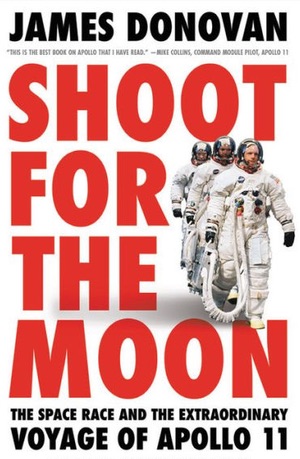Review: Shoot for the Moonby Jeff Foust
|
| For those unfamiliar with Apollo 11 or the early American space program in general, Shoot for the Moon is a good place to start. But if you’re reading this publication, you’re likely already quite familiar with all that. |
The new documentary Apollo 11 succeeded because it was able to stand out, thanks to previously unseen footage cleverly crafted to make viewers feel like they were watching the mission for the first time. The new book Shoot for the Moon is less successful in that respect. While it does a good job telling the story of Apollo 11, and the space race that led up to it, it offers little, if anything, new to our understanding of those events.
Donovan offers a fairly straightforward history of the space program in the US, starting with the prehistory of von Braun’s V-2 through the shock of Sputnik and then on through Mercury, Gemini, and Apollo. The focus is on America’s human spaceflight program and the race to the Moon, but with some discussion of Soviet efforts (within that narrative of a race between the US and USSR) and some robotic missions.
He keeps a fast pace to the book, cramming all of that history, up through the Apollo 11 mission, into 400 pages. (The book abruptly ends after Apollo 11; a three-page epilogue covers the rest of the Apollo program and the decades that followed.) The book mixes technical information with personal anecdotes about the astronauts and others involved in the program, like Steve Bales and Jack Garman, the flight controllers who identified and correctly diagnosed the computer alarms during the descent to the lunar surface by the Eagle.
That said, those already familiar with the history of Apollo 11 and the space program of that era will find little in the way of new information in the book. Donovan appears to have relied heavily on secondary sources, including many previous books and articles, for Shoot for the Moon, based on its bibliography. He did perform some interviews, including with Apollo astronauts, but those interviews didn’t seem to provide much in the way of revelations or novel insights about Apollo 11 or the overall program. There’s also no attempt to critically reexamine that history in light of the knowledge that’s come to light in the half-century since Apollo 11.
For those unfamiliar with Apollo 11 or the early American space program in general, Shoot for the Moon is a good place to start: it offers a compact history of the events leading up to humanity’s first footprints on the Moon. If you’re reading this publication, though, you’re likely already quite familiar with all that. In that case, the book won’t offer much in the way of new details or revelations about the overall program or Apollo 11. It’s a lesson to keep in mind as more books about the mission appear in the coming months.
Note: we are temporarily moderating all comments subcommitted to deal with a surge in spam.
